The ingot is the most important product in the steel chain and is located in the middle part of the production chain. The importance of this product is due to the fact that the products produced after it (which are actually the products consumed in the market and in general) are clearly and specifically related to the quality of the produced ingot. depend
The strength, elasticity and flexibility of the produced rebar, as well as the quality and polishing of the sheets produced from slabs, etc., all depend on this stage and the quality of this type of intermediate products.
Different methods for producing ingots were considered from the beginning, which changed day by day and with the advancement of industry and technology, or they lost their nature altogether and other methods have replaced them.

In the following, two up-to-date and practical methods with the highest quality in production and their prevalence in the world are examined, and the types of products produced from these two methods are introduced in the following.
Electric arc furnaces (EAF) and induction furnaces (IMF):
In this method, scrap iron is poured into the electric arc furnace with special baskets, and then sponge iron is added to the furnace with slag-making materials such as coke, lime, bentonite, etc. from above. After adding these materials, sampling, oxygen blowing, homogenization and analysis are carried out so that the materials inside the furnace turn into molten steel.
Molten steel is taken to the casting unit after the impurity is separated by the molten steel. In casting, the molten material is poured into containers called tandish, and then, through the tandish nozzle, the molten material is poured into a copper mold whose walls are cooled by water. These molds are located on a roller and sprinkled Water cools the molten material inside it. Next, the obtained cooled ingots are cut to the desired lengths.
Blast furnace (BF) method:
More than 90% of iron ore mined in the world is used in blast furnaces. In this method, iron ore is poured into the blast furnace along with coke and lime after it is pre-baked and lumped, and raw iron or cast iron is obtained.
Crude iron is converted into molten steel in the converter, then the impurities of crude steel such as carbon are separated from it by oxygen to obtain crude steel. Molten steel is taken to the casting unit after the impurity is separated by the molten steel.
The molten material is poured into the ingot molds in the casting unit and placed on a roller and cooled by spraying water and after cooling, the steel ingot is cut to the desired length.
The difference between ingot, billet, bloom and slab
To check the differences between these 4 semi-finished products, which are also known as intermediate rolled steel products, it is better to get acquainted with their definitions first.
Ingot:
The ingots have a trapezoidal surface, the length of each branch of which is a maximum of 2 meters. The appearance of the ingots makes them easy to transport.
Billet:
A billet, also known as a billet, is longer than a billet and has a circular or square surface with a width of less than 15 centimeters, or in other words, a cross-sectional area of less than 230 square centimeters, and they have lengths of 6 and 12 meters.
Bloom:
Bloom, which is also known as billet, is actually the same as billet, but with a width of more than 15 cm, or in other words, a cross-sectional area greater than 230 square centimeters, for this reason, bloom and billet are usually placed in the same category. Bloom’s main uses are for making rails, shields, studs, cans, iron beams, etc.
Slab:
Unlike billet and bloom, the surface of the slab is rectangular and usually has a thickness of 230 mm, a width of 1.25 meters and a length of 12 meters. Slab is the raw material for making steel sheet. Slab T is also called Takthal.
According to the above definitions, it can be concluded that the difference between these 4 products is in their cross section shape and dimensions.



